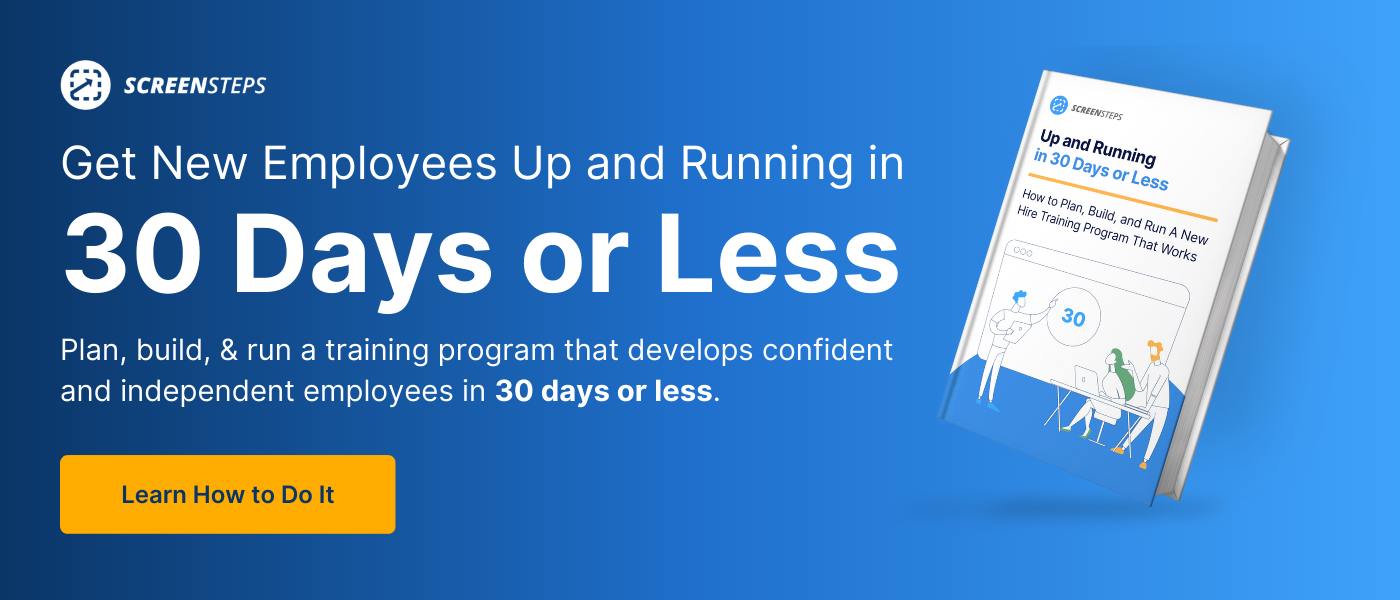11 Signs Your Employee Training Program Isn't Working
Building an employee training program is not an easy feat.
You put a lot of time and effort into your training program. It takes preparing PowerPoints, creating documents, writing quizzes, collecting materials, and more.
It is frustrating when your employees complete your training program and haven’t grasped the concepts you taught them, it is frustrating. Something seems off. You aren’t getting the results you want.
Working for ScreenSteps — a knowledge base and training software company — I’ve learned a lot by studying different employee training techniques. There are many ways to train employees. Some merely teach them information, while others enable employees to do their jobs. The goal, of course, is to achieve the second one.
How do you know you are falling into that undesired first category?
Here are 11 signs your employee training program isn’t working. Of course, we are all always looking for ways to improve. So, in each warning sign, there are suggestions for how to turn that aspect of your training program around.
1. Trainers and supervisors aren’t aligned
After training, the trainers hand off the new hires (aka employees) to the team supervisors and managers. Then supervisors and managers ensure the employees properly perform the tasks they learned in training.
If your supervisors feel a need to return to trainers and ask them, “Did you cover ________ during training?” There is a disconnect between onboarding and on-the-job performance. Or if the trainer answers, “Yes, a dozen times!” then the approach to training may not be working.
This can happen if the trainer doesn’t know what employees actually do while on the job. The trainer hasn’t coordinated with the supervisors to align what they are covering during training with what’s expected on the job site.
As you develop your employee training program, trainers should meet with supervisors to discuss what they need to be cover in training.
2. Employees are making mistakes
Are your employees frequently making mistakes? Mistakes can be costly, so your company wants to do everything possible to prevent mistakes.
Of course, employee mistakes could be a result of many things:
- Employees didn’t pay attention
- Reference guides are outdated or have incorrect information
- It wasn’t covered in training
It is important to pause and evaluate your systems when employees are making frequent mistakes.
It’s worth analyzing your training program — or even just adjusting training on a particular procedure if that is where the mistakes are being made — to see if there is a better approach to teaching employees.
3. Training takes too long
How long should training take? There is no magic rule of thumb for how long training should take. It depends on your company and the complexity of assignments and procedures your employees will be handling.
However, there is a point where training crosses into more of a certificate or even college degree level than a simple onboarding program.
With the right training program, your new hires should be able to achieve proficiency in a few weeks to a few months. Training that drags on for 3-6 months is discouraging (not to mention costly to your company).
🔎 Related: How Long Does Call Center Training Take? (+ How to Cut Training Time)
4. Training is primarily lecture-based
An employee training program that is focused on lectures, PowerPoint presentations, etc. is not the most engaging approach to training.
This training format doesn’t require your learner to pay attention. It is easy for them to daydream of after-work plans, their true crime podcast, or something more exciting in their lives.
Here’s the thing: Your employees’ job description isn’t to listen to lectures day-in and day-out. After training, they will rarely be attending lectures. Their jobs will be handling different tasks. They don’t just need to know how that is done — they need to be able to do it.
Learning isn’t about being spoon-fed knowledge. It involves experiencing and familiarizing themselves with what they will be every day. This leads perfectly to the next sign.
5. Training doesn’t include hands-on activities
Do you include hands-on activities as part of your employee training curriculum?
As I said before, training is supposed to help employees learn to DO something — not just know something. Memorizing information isn’t enough to prepare an employee for the workplace.
Practice on-the-job situations. This training technique is often referred to as scenario-based training. Scenario-based training is where trainees role-play different scenarios that they will encounter on the job. This gives them exposure and practice doing their real tasks.
6. Training doesn’t include realistic scenarios
If you do include role-playing activities but those activities don’t match with what they will do once they complete training, the role-playing won’t help them.
Use the past to help with the future. By that I mean, use real situations or scenarios your employees have had on the job.
And if all the scenarios you have your new hires try work out perfectly and only have one outcome, that won’t help them be prepared when things aren’t textbook on the job. Throw some curveballs at them. Adjust the scenarios so they learn to adapt and find answers they need.
7. Employees don’t have access to materials they used during training
One mistake companies often make is providing one resource to employees during training (training guides) and then providing employees with different job aids (or nothing) following training.
But, why? Your employees should be learning and practicing the same things in training that they will be doing on the job. Those outlines and guides you used in training can help employees on the job after training is complete.
Of course, employees can’t use the guides if they don’t have access to the materials.
Tech Tip: Create a one-stop shop for your materials that employees can access during training and on the job. This could be a knowledge base, document library, call flow software, or another knowledge management system that centralizes your company resources.
🔎 Related: Job Aids vs Training Guides: When to Use Each
8. Trainers walk learners through every click during training
Do you find yourself telling everyone where to click during the training? Do you have to tell everyone what the next step is?
If you have to walk a new hire through every step of a process during training, it sets a precedent for the job that there will always be someone to help them.
Yes, you will need to offer more help as new hires begin practicing different scenarios. However, the goal is for employees to be independent and confident workers by the end of training.
You can’t achieve this if you are holding their hands through every step and not letting them struggle to complete tasks on their own.
9. You have technical issues during training
It is so frustrating when your technology isn’t working during training. Maybe the new hires can’t get into the programs they need for practice or the internet isn’t working well in the room.
If you are prone to technical issues, that requires better coordination with your IT department. Set up your training area before training starts so that you can catch any glitches ahead of time.
10. Learners are passing quizzes but not performing proficiently
Part of training often includes assessing your trainees’ knowledge with quizzes. It can be baffling when your trainees are passing your quizzes but then they aren’t able to perform tasks proficiently.
They seem to know everything that you’ve taught them, so why can’t they do the assignment?
This could go back to signs 4, 5, and 6. Your quizzes are testing what your employees KNOW, not what they can DO. If you want to see how they will perform, your assessments should include performing those tasks.
11. Employees regularly ask for help post-training
When your employees complete training, are they independent workers? Do they have to ask their supervisors or neighbors questions frequently to complete assignments?
If employees are regularly asking for help with common procedural tasks, they didn’t get everything they needed out of training. You don’t want your learners completing training and still not knowing how to do their jobs.
Of course, a few questions in the first week or two out of training are okay. You want your employees to be so comfortable that they rarely ask questions.
Build a training program that prepares employees to be independent on the job
To sum up, if your employees can’t perform their jobs after training, then your training needs improvements. It isn’t working. The whole point of training is to prepare your employees so that they can do their jobs independently.
Does adjusting training so that it achieves all of this seem impossible? With the right interactive training plan, it is possible to train independent employees.
When you adopt the Find & Follow Training Framework, you prepare your employees to be more knowledgeable, consistent, and efficient in 30 days or less.
Employees work independently and with more confidence. That’s because they learn how to use their ScreenSteps knowledge base to find the answers they need in seconds.
Learn about the three phases of the Find & Follow Training Framework as well as which assets you need to prepare to adopt that framework. This article will help you understand if and how you could adjust your employee training program.





